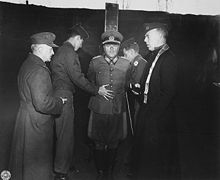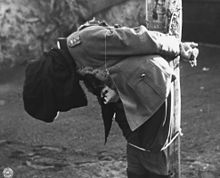Anton Dostler


Anton Dostler (Munich, May 10, 1891 – Aversa, December 1, 1945) was a General of the Infantry in the regular German army during World War II. In the first allied war trial after the war, Dostler was tried and found guilty of war crimes and sentenced to death by firing squad.
Military career
Anton Dostler joined the German Army in 1910 and served as a junior officer during WWI. From the start of WWII to 1940, he served as Chief of Staff of the 7th Army. Subsequently, he commanded the 57th Infantry Division (1941-1942), the 163rd Infantry Division (1942) and the 42nd Army Corps (1943-1944). He was appointed to command the 75th Army Corps in January 1944.
Execution of U.S. soldiers
On March 22, 1944, fifteen men of the U.S. Army, including two officers, landed on the Italian coast about 100 kilometres north of La Spezia, 250 miles behind the then established front. Their mission was to demolish a railroad tunnel between La Spezia and Genoa. Two days later, the group was captured by a party of Italian Fascista soldiers and members of the German Wehrmarcht. They were taken to La Spezia, where they were confined near the headquarters of the 135th Fortress Brigade, which was under the command of German Colonel Almers. The immediate, superior command was that of the 75th Army Corps, commanded by Dostler.
The captured U.S. soldiers were interrogated and one of the U.S. officers revealed the story of the mission. This information was then sent to Dostler at the 75th Army Corps. The following day (March 25), Dostler sent a telegram to the 135th Fortress Brigade ordering that the captured soldiers be executed. Officers at the 135th Fortress Brigade contacted Dostler in an attempt to achieve a stay. Dostler then sent another telegram ordering Almers to carry out the execution. Two last attempts were made by the officers at the 135th, including some by telephone. These efforts were unsuccessful and the fifteen Americans were executed on the morning of March 26, 1944. Alexander zu Dohna-Schlobitten, who refused to sign the execution order, was dismissed from Wehrmacht for insubordination.[1]
Trial, execution and notoriety
In the first Allied war trial, Dostler was accused of carrying out an illegal order, while Dostler maintained that he did not issue the order, but only passed along an order to Colonel Almers from supreme command. The trial found General Dostler guilty of war crimes.
He was sentenced to death and shot by a firing squad on December 1, 1945 in Aversa. The execution was photographed on black and white still and movie cameras. [2]
References
- ^ Alexander Fürst Dohna-Schlobitten, Erinnerungen eines alten Ostpreußen. ISBN 3800331152, 2006 Template:De icon
- ^ Film of execution from three camera angles
External links
- The Dostler Case
- Dostler's defense Explained by Kent Emery, Jr., son of one of Dostler's defense attorneys.
- Video of General Dostler's last minutes on December 1st, 1945
- 1891 births
- 1945 deaths
- German military personnel of World War I
- German military personnel of World War II
- People executed by firing squad
- German people convicted of war crimes
- Executed generals and admirals
- Bavarian generals
- People from Munich
- People from the Kingdom of Bavaria
- Executed German people
- Filmed executions
